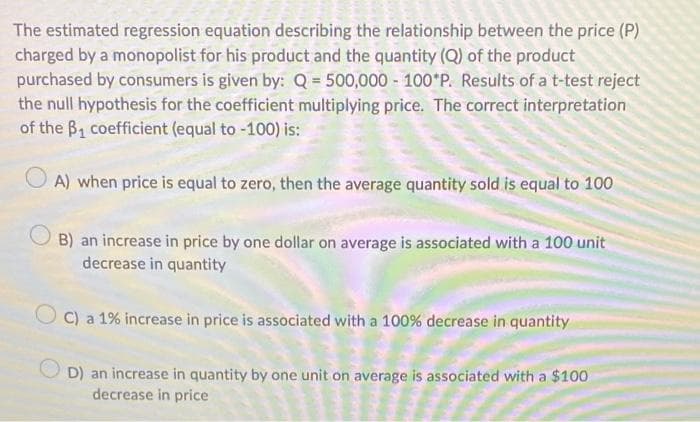The estimated regression equation describing the relationship between the price (P) charged by a monopolist for his product and the quantity (Q) of the product purchased by consumers is given by: Q = 500,000 - 100*P. Results of a t-test reject the null hypothesis for the coefficient multiplying price. The correct interpretation of the B₁ coefficient (equal to -100) is: OA) when price is equal to zero, then the average quantity sold is equal to 100 B) an increase in price by one dollar on average is associated with a 100 unit decrease in quantity OC) a 1% increase in price is associated with a 100% decrease in quantity D) an increase in quantity by one unit on average is associated with a $100 decrease in price
The estimated regression equation describing the relationship between the price (P) charged by a monopolist for his product and the quantity (Q) of the product purchased by consumers is given by: Q = 500,000 - 100*P. Results of a t-test reject the null hypothesis for the coefficient multiplying price. The correct interpretation of the B₁ coefficient (equal to -100) is: OA) when price is equal to zero, then the average quantity sold is equal to 100 B) an increase in price by one dollar on average is associated with a 100 unit decrease in quantity OC) a 1% increase in price is associated with a 100% decrease in quantity D) an increase in quantity by one unit on average is associated with a $100 decrease in price
Managerial Economics: Applications, Strategies and Tactics (MindTap Course List)
14th Edition
ISBN:9781305506381
Author:James R. McGuigan, R. Charles Moyer, Frederick H.deB. Harris
Publisher:James R. McGuigan, R. Charles Moyer, Frederick H.deB. Harris
Chapter4: Estimating Demand
Section: Chapter Questions
Problem 1E
Related questions
Question

Transcribed Image Text:The estimated regression equation describing the relationship between the price (P)
charged by a monopolist for his product and the quantity (Q) of the product
purchased by consumers is given by: Q = 500,000 - 100 P. Results of a t-test reject
the null hypothesis for the coefficient multiplying price. The correct interpretation
of the B₁ coefficient (equal to -100) is:
A) when price is equal to zero, then the average quantity sold is equal to 100
B) an increase in price by one dollar on average is associated with a 100 unit
decrease in quantity
C) a 1% increase in price is associated with a 100% decrease in quantity
OD) an increase in quantity by one unit on average is associated with a $100
decrease in price
Expert Solution
This question has been solved!
Explore an expertly crafted, step-by-step solution for a thorough understanding of key concepts.
Step by step
Solved in 2 steps

Knowledge Booster
Learn more about
Need a deep-dive on the concept behind this application? Look no further. Learn more about this topic, economics and related others by exploring similar questions and additional content below.Recommended textbooks for you

Managerial Economics: Applications, Strategies an…
Economics
ISBN:
9781305506381
Author:
James R. McGuigan, R. Charles Moyer, Frederick H.deB. Harris
Publisher:
Cengage Learning

Managerial Economics: Applications, Strategies an…
Economics
ISBN:
9781305506381
Author:
James R. McGuigan, R. Charles Moyer, Frederick H.deB. Harris
Publisher:
Cengage Learning